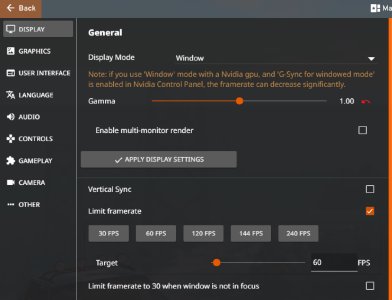Deterministic Mode
Deterministic Mode is a setting meant to bypass nondeterminism in the physics simulation introduced by hardware-related variations in computation time. Because video games are rendered at variable frame rates, and the simulation is advanced based on the time between those frames, multiple simulations of the same scenario can vary slightly due them being paced at nondeterministic rates. Deterministic Mode makes that rate constant, eliminating that source of randomness at the cost of possibly choppier graphics output.
Usage
The Lua functions which can enable deterministic mode by decoupling the physics and graphics steps are:
be:setPhysicsSpeedFactor(factor)
Sets the physics timing between frames.
Args:
factor(int): The factor to set. Which mode the physics are running in are determined by the exact value passed. It boils down to:
-1: Run1.0/fpslimitseconds of physics per rendered graphics frame0: Simulate physics time based on wallclock delta to the last graphics framen: Simulaten * 50msof physics per rendered graphics frame (for any positiven)
Any nonzero input will make physics deterministic, as the times between steps is made constant and not tied to rendering times. Any positive input to the function decouples physics and graphics frames, meaning the simulation will not be real-time anymore (it can be either faster or slower, depending on the settings and performance). be:setPhysicsSpeedFactor(-1) will keep the simulation real-time as long as the framerate is constantly reaching fpslimit (so you have the frame limiter enabled and the computer performance is good enough to reach that framerate).
Note that when n ≥ 1 the updateGFX callback functions of control systems will still be called at a fixed interval of 50ms, but actual rendered frames will be at an interval of n * 50ms. This is to not deteriorate the accuracy of control systems that run in the updateGFX callback when deterministic mode is enabled and less rendered frames are desired by the user.
Returns:
nil
be:setPhysicsDeterministic(deterministic)
Alternative function for setting the physics timing between frames.
Args:
deterministic(bool):
true: short hand forbe:setPhysicsSpeedFactor(1)false: short hand forbe:setPhysicsSpeedFactor(0)
Returns:
nil
Faster than Real-Time Simulation
You can use the deterministic mode to run the simulation faster-than-realtime if the system can run the physics fast enough. You can either run the physics as fast as possible with time-varying speedup, or set a “maximum constant factor speedup” using the graphics frame limiter. This section describes both approaches.
As Fast as Possible
Simply run be:setPhysicsDeterministic(true). For maximum possible speedup, also disable the frame limiter.
Maximum Constant Factor
This mode is useful if you want to run the simulation at say 2x speed of real-time, or any other constant factor.
This mode requires the frame limiter to be enabled. To do so, you can either use the Lua code provided below, or set the limit in the settings. For the latter, navigate to Options > Display > Limit framerate and set it to a desired value. You should use a value that your system can handle rendering:
You have to calculate the amount of 50ms iterations that need to be run for the maximum constant factor speedup. The following code does that:
fpslimit = 40 -- set to a value that your PC can handle and also 20 / fpslimit * factor has to be an integer
factor = 2 -- maximum speed up factor
settings.setValue('fpsLimit', fpslimit)
settings.setValue('fpsLimitEnabled', true)
iterations = 20 / fpslimit * factor -- this has to be an integer!
be:setPhysicsSpeedFactor(iterations)
Limitations:
- The factor is the upper limit of the speedup. If the framerate is lower than what is set in the frame limiter, the speedup will be lower than the factor.
20 / fpslimit * factorhas to be an integer andfpslimitshould be at least20. Examples: For 2x speedup, this means the frame limiter has to be set to either 20 or 40. For 3x speedup, the possible values are 20, 30 and 60.
Was this article helpful?

